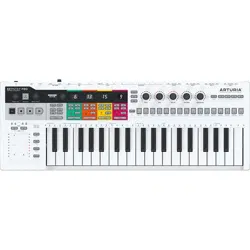Loading ...
Loading ...
Loading ...

10.6. Routing Signals
For each Track, you can decide to which Voice output(s) its CV/Gate signals will be routed.
By default, Track 1 will use Voice 1, Track 2 Voice 2, Track 3 Voice 3 and Track 4 Voice 4.
Hold down 'Shift' and press one or a combination of the CV Routing keys (G#, A, A#, B in the
upper octave). This will route the current Track to those Voices. You can repeat this action for
the other three Tracks. Switching to a Track will activate the Voice outputs you've assigned
to it.
CAUTION: When you try to assign a Voice to a Track and it is already assigned to another Track, the
new routing will overwrite the existing one.
While routing CV signals, watching the LEDs can be helpful. Voices already assigned to
the current Track will be indicated with brightly lit LEDs. To cancel that assignment, hit the
corresponding key. The LEDs of Voices assigned to other Tracks will be dimly lit.
10.6.1. Voice Allocation
What happens if you send two almost simultaneous notes to a Voice output when the
voltage-controlled oscillator (VCO) connected to it is monophonic, meaning that it can only
sound one note at a time? Unlike male humans who tend to get confused when having to
do two things simultaneously, the Voice output circuitry knows exactly what to do: the
last
note you played will have priority. Every new note you play will 'kill' the previous one. If you
play two notes almost simultaneously, the note of the last key you press will be heard. Even
if you play more than two keys, it's always the last key you'll hear.
How does this work when you're playing a sequence (Pattern) and have more than one note
stored in a step? The Voice output will solve this be playing only the
lowest
note of the chord
stored in the step.
The KeyStep Pro has another trick up its sleeve: let's say you have a sequence (Pattern)
playing in Track 1 with a 4-note chord in each step and you assign the output of Track 1 to
Voices 1 to 4. What will happen? The KeyStep Pro will silently applaud your brilliant idea
while calmly distributing the notes in your step over the four Voice outputs!
If you have more than four notes in a step, the KeyStep Pro will 'steal' voices to solve that
problem; with five notes in a chord, the lowest note of the chord will be dropped, sacrificed
to play the fifth note. With six notes in a chord, the lowest two will be dropped ... you get the
idea.
Typically, the Pitch (CV) output is connected to a voltage-controlled oscillator (VCO), the Gate
output is connected to some trigger input or the gate input of a voltage-controlled amplifier
(VCA), and the Velocity output is connected to a CV input of a VCA or a voltage-controlled
filter (VCF) or both (through a patch bay or a CV splitter). These typical routings will produce
the most predictable results, but you can creatively route these signals to any parameter
that will accept them.
10.6.2. Shift Magic
All of the keyboard Shift functions will work their magic on the CV outputs: for example, <
Nudge and Nudge > will nudge your sequence Pattern to the left or the right; Semi Down and
Semi Up will transpose your sequence Pattern within the current scale.
The keyboard Shift functions will also work on the CV outputs! You can change Seq Pattern
direction, change the Time Division, Scale and Root Note and set a custom User 1 or User 2
scale.
Arturia - User Manual Keystep Pro - KeyStep Pro and your Modular system 173
Loading ...
Loading ...
Loading ...
